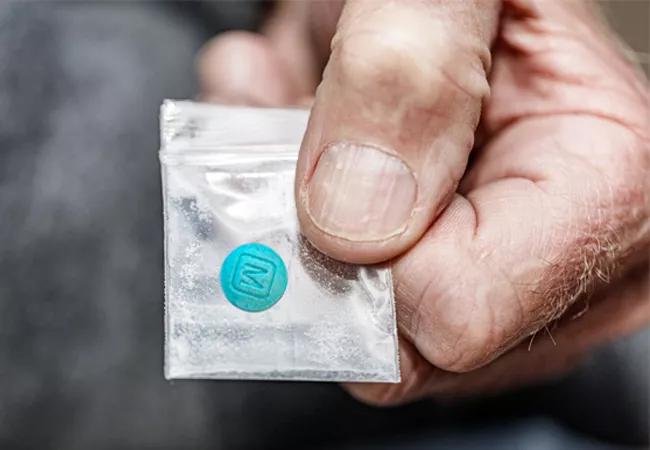Urine test strips and point-of-care testing may be key to slowing opioid epidemic

Psychiatrists warn that the deadly U.S. opioid epidemic is experiencing a “third wave” marked by the rise of illicitly manufactured synthetic opioids, primarily fentanyl and its ultrapotent analogues, which have surpassed prescription opioids as the leading cause of overdose-related deaths.
Advertisement
Cleveland Clinic is a non-profit academic medical center. Advertising on our site helps support our mission. We do not endorse non-Cleveland Clinic products or services. Policy
Although several social and physiological factors contribute to the lethality of fentanyl, experts say it is particularly concerning that those who use the drug are unable to determine whether a dose may be deadly based on visual inspection alone. In an op-ed published in a recent issue of the New England Journal of Medicine, Cleveland Clinic psychiatrist and lead author Brian Barnett, MD, explains, “Although fentanyl is now the dominant driver of the opioid epidemic, our healthcare system has struggled to adapt toxicology screening practices to this reality.”
There are no reliable FDA–approved self-testing kits, and the widespread adoption of routine fentanyl immunoassay screening has been insufficient. Even in settings where a point-of-care (POC) fentanyl test is available, results can be slow and difficult to interpret. Furthermore, these tests must be processed in a laboratory capable of performing “high-complexity” tests, according to the Clinical Laboratory Improvement Amendments of 1988 (CLIA), the federal standards that govern the evaluation of human specimens.
Barnett and his coauthors explain that the lack of POC fentanyl testing has slowed efforts to “better characterize the patterns and correlates of fentanyl use. Such information is important, since many people are unintentionally exposed to fentanyl, which is used to adulterate not only street supplies of heroin, but also cocaine, methamphetamine and counterfeit tablets marketed as various drugs.” In fact, a 2020 study revealed that only 5% of those presenting with fentanyl overdose were aware of having been exposed to the drug.1
Advertisement
The authors note that the limited availability of POC fentanyl testing is also “hamstringing clinicians’ efforts to effectively manage fentanyl exposures.” In many cases, providers miss the opportunity to provide high-risk patients with potentially lifesaving information about unintentional exposures, treatment resources and harm-reduction strategies.
Fentanyl itself has also impeded clinicians’ efforts to manage opioid withdrawal with buprenorphine, which requires a waiting period (typically 12- to 16-hours after heroin use) before initiation, says Barnett. Despite being a short-acting opioid, fentanyl is slow to clear the body – a feature that can precipitate delayed withdrawal. Unfortunately, the severe discomfort this can cause may provoke patients to abandon buprenorphine treatment prematurely.
“Scaling up POC fentanyl testing therefore remains an important intervention for informing clinical decisions about the timing and safety of buprenorphine induction,” the authors explain.
In 2022, the FDA cleared a qualitative POC instrument for testing urine for fentanyl. Manufactured by Shenzhen Superbio Technology, the tool has a high sensitivity and specificity that Barnett and his colleagues say may provide an appealing solution for healthcare facilities interested in scaling up their POC fentanyl testing. Although Shenzhen’s fentanyl test has been approved by the FDA, it is categorized as “moderate complexity” – a classification that requires testing sites to be CLIA-certified, submit to routine lab inspections and provide caregiver training. Unfortunately, the costliness of the instrument coupled with these regulatory demands have made it an impractical tool for home use and many community hospitals.
Advertisement
In light of these restrictions, the authors suggest that urine fentanyl test strips, the results of which can be immediately visualized, may be a viable, low-cost alternative to POC testing. Although the strips lack FDA approval, they are commercially available for assessing street-acquired drugs for the presence of fentanyl and its analogues. (The strips have been shown to outperform two spectrometer-based tests for this purpose.)2
Barnett and his coauthors encourage the FDA to expand access to POC fentanyl testing for patients and less-resourced healthcare facilities by applying the CLIA waiver to urine test strips and other POC fentanyl tests. They note that the waiver already applies to commercially available urine pregnancy and fingerstick blood glucose tests. “To qualify for a CLIA waiver, a test must be simple to administer, use unprocessed specimens, and have an insignificant risk of inaccurate results — standards that many POC fentanyl tests probably already meet,” the op-ed explains.
The availability of the first FDA-cleared POC fentanyl test, which the authors describe as a “long-overdue, potentially lifesaving tool” is particularly important, given the widespread adulteration of street opioids (most recently with xylazine).“This development will not solve all our fentanyl testing needs, but we hope it will catalyze efforts by regulators and manufacturers to expand access to less resource-intensive types of POC testing for fentanyl and other adulterants,” they conclude.
Advertisement
Advertisement

Two NIH grants are looking at developing new antidotes against fentanyl overdose

Clinical judgment is foundational to appropriately prescribing

Expert urges action to mitigate the tragedy of fatal overdose

Cleveland Clinic study points to need for new strategies to curb addiction relapse

Study sheds light on how clinicians addressed their patients’ pain and insomnia during the pandemic

A public health tragedy with persistent pathophysiological and therapeutic challenges

Reducing prescriptions may help keep unused medication out of the community

Swift, aggressive thiamin therapy may be key to preventing long-term neurological injury